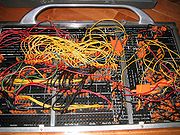
IBM 402
Encyclopedia

Punched card
A punched card, punch card, IBM card, or Hollerith card is a piece of stiff paper that contains digital information represented by the presence or absence of holes in predefined positions...
s at a speed of up to 150 cards per minute, while printing data at a speed of up to 100 lines per minute with 43 alpha-numerical type bars and 45 numerical type bars. The IBM 403 added the ability to print up to three lines --e.g. a multiline shipping address--from one card instead of just one line with the 402. Like other IBM unit record equipment
Unit record equipment
Before the advent of electronic computers, data processing was performed using electromechanical devices called unit record equipment, electric accounting machines or tabulating machines. Unit record machines were as ubiquitous in industry and government in the first half of the twentieth century...
, the 402 and 403 were controlled by a removable plugboard
Plugboard
A plugboard, or control panel , is an array of jacks, or hubs, into which patch cords can be inserted to complete an electrical circuit. Control panels were used to direct the operation of some unit record equipment...
.
In July 2010, a group from the Computer History Museum
Computer History Museum
The Computer History Museum is a museum established in 1996 in Mountain View, California, USA. The Museum is dedicated to preserving and presenting the stories and artifacts of the information age, and exploring the computing revolution and its impact on our lives.-History:The museum's origins...
reported that an IBM 402 was still in operation at a filter manufacturing company in Conroe, Texas
Conroe, Texas
Conroe is a suburban city 40 miles north of Houston in the gulf coastal plains/piney woods region of southeast Texas.It is the seat of Montgomery County and falls within the metropolitan area.As of the 2000 U.S...
.

